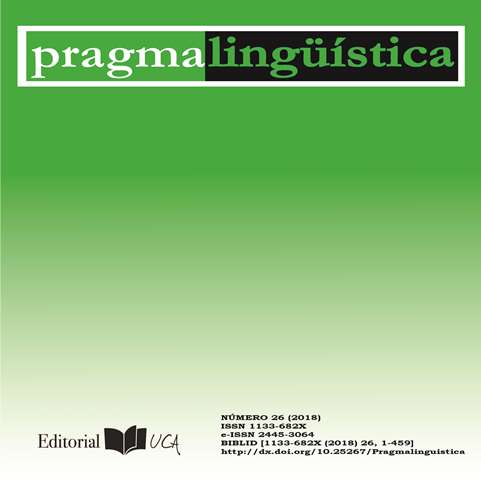Estudio contrastivo intercultural de las funciones retóricas de las citas: la producción de textos académicos en el nivel de posgrado escritos en español e inglés

DOI
https://doi.org/10.25267/Pragmalinguistica.2018.i26.18%20Información
Resumen
El objetivo principal que persigue nuestra investigación es el de descubrir cuáles son las funciones retóricas que desempeñan las citas en la escritura de un trabajo de investigación universitario de máster realizado por 8 estudiantes españoles y 8 estadounidenses en su lengua nativa. Para estudiar este fenómeno se utilizó la metodología del análisis textual computarizado de las funciones retóricas de las citas (Petrić, 2007). Los resultados obtenidos en la investigación mostraron que las diferentes convenciones culturales en la composición de las memorias estudiadas apuntan unas tendencias generales en el número más elevado de las citas y en la longitud mayor de las secciones de la Introducción y la Conclusión en los textos escritos en inglés con respecto al grupo español nativo. Por otro lado, los informantes estadounidenses utilizaron un estilo más dialógico que los españoles en el uso de la citación.
Palabras clave
Descargas
Agencias de apoyo
Cómo citar
Licencia
Derechos de autor 2018 Pragmalingüística

Esta obra está bajo una licencia internacional Creative Commons Atribución-NoComercial-CompartirIgual 4.0.
Citas
BAZERMAN, C. (2003): “Intertextuality: how texts rely on other texts”, Bazerman, C. y Prior, P. (eds.): What writing does and how it does it: An introduction to analyzing texts and textual practices, New Jersey: Lawrence Erlbaum Associates Publishers, PP. 83-96.
BROOKS, T.A. (1985): “Private acts and public objects: an investigation of citer motivations”, Journal of the American Society for Information Science, 36, pp. 223-229.
CONNOR, U. (1996): Contrastive Rhetoric. Cross-cultural aspects of second language writing, Cambridge: Cambridge University Press.
CONNOR, U. (2008): “Mapping multidimensional aspects of research: Reaching to intercultural rhetoric”, Connor, U., Nagelhout, E. y Rozycki, W. V. (eds.): Contrastive rhetoric: Reaching to intercultural rhetoric, Amsterdam: John Benjamins, pp. 299-315.
DONG, Y.R. (1996): “Learning how to use citations for knowledge transformation: non-native doctoral student´s dissertation writing in science”, Research in the Teaching of English, 30(4), pp. 428-457.
FLØTTUM, K., DAHL, T. y KINN, T. (2006): Academic voices: Across languages and disciplines, Amsterdam/Philadelphia: John Benjamins.
HARWOOD, N. (2009): “An interview-based study of the functions of citations in academic writing across two disciplines”, Journal of Pragmatics, 41(3), pp. 497-518.
HYLAND, K. (1999): “Academic Attribution: Citation and the Construction of Disciplinary Knowledge”, Applied Linguistics, 20 (3), pp. 341-367.
HYLAND, K. (2002): “Authority and invisibility: authorial identity in academic writing”, Journal of Pragmatics, 34, pp. 1091-1112.
HYLAND, K. (2011): “Projecting an academic identity in some reflective genres”, Ibérica, 21, pp. 9-30.
IVANIČ, R. y CAMPS, D. (2001): “I am how I sound: Voice as self-representation in L2 writing”, Journal of Second Language Writing, 10, pp. 3‐33.
JALILIFAR, A. (2012): “Academic attribution: citation analysis in master’s theses and research articles in applied linguistics”, International Journal of Applied Linguistics, 22(1), pp. 23-41.
KAPLAN, R. B. (1966): “Cultural Thought Patterns in Inter-cultural Education”, Language Learning, 16(1-2), pp. 1-20.
KINKEAD, J. (2001): “The National Writing Centers Association as Mooring: A Personal History of the First Decade”, Barnett, R.W. y Blumner, J. S. (eds.): The Allyn and Bacon Guide to Writing Center Theory and Practice, Boston: Allyn and Bacon, pp. 29-40.
LACA, B. (2001): “Otras instancias enunciativas”, Vázquez, G. (coord.): Guía didáctica del discurso académico escrito: ¿cómo se escribe una monografía?, Madrid: Edinumen, pp. 81-94.
MANSOURIZADEH, K. y AHMAD, U.K. (2011): “Citation practices among non-native expert and novice scientific writers”, Journal of English for Academic Purposes, 10, pp. 152-161.
MAYOR SERRANO, M.B. (2006): “La citación en la comunicación médica escrita (inglés-español): funciones y tipos”, Lebende Sprachen, 51(2), pp. 72-78.
MORAVCSIK, M.J. y MURUGESAN, P. (1975): “Some results on the function and quality of citations”, Social Studies of Science, 5, 86-92.
MUR DUEÑAS, P. (2009): “Citation in business management research articles: A contrastive (English-Spanish) corpus-based analysis”, Suomela-Salmi, E. y Dervin, F. (eds.): Cross-Linguistic and Cross-Cultural Perspectives on Academic Discourse, Amsterdam: John Benjamins, pp. 49-60.
SAMRAJ, B. (2002): “Introductions in research articles: Variations across disciplines”, English for Specific Purposes, 21(1), pp. 1–17.
SÁNCHEZ-JIMÉNEZ, D. (2011): “Revisión de estudios sobre las funciones de las citas en textos académicos escritos por estudiantes de posgrado nativos y no nativos que aprenden una lengua extranjera”, Marcoele, 13, pp. 1-22.
SÁNCHEZ-JIMÉNEZ, D. (2012): “El uso de las funciones de las citas en la estructura retórica de las Introducciones de memorias de máster escritas en español por estudiantes nativos españoles y filipinos no nativos”, Revista Nebrija de Lingüística Aplicada a la Enseñanza de Lenguas, 12, pp. 137-187.
SÁNCHEZ-JIMÉNEZ, D. (2013): “Aplicabilidad de la tipología de las funciones retóricas de las citas al género de la memoria de máster en un contexto transcultural de enseñanza universitaria”, Revista Signos 46(81), pp. 82-104.
SOLER-MONREAL, C y GIL-SALOM, L. (2011): “A cross-language study on citation practice in PhD thesis”, International Journal of English Studies, 11(2), pp. 53-75.
SUMMERFIELD, J. (2001): “Writing Centers: A Long View”, Barnett, R. W. y Blumner, J. S. (eds.): The Allyn and Bacon Guide to Writing Center Theory and Practice, Boston: Allyn and Bacon, pp. 22-28.
SWALES, J. (1990): Genre analysis: English in academic and research settings, Cambridge. England and New York: Cambridge University Press.
THOMPSON, P. (2001): A pedagogically-motivated corpus-based examination of PhD theses: macroestructure, citation practices and uses of modal verbs. Tesis doctoral (PhD). Reading: University of Reading.
THOMPSON, P. (2005): “Points of focus and position intertextual reference in PhD theses”, Journal of English for Academic Purposes, 4, pp. 307-323.






